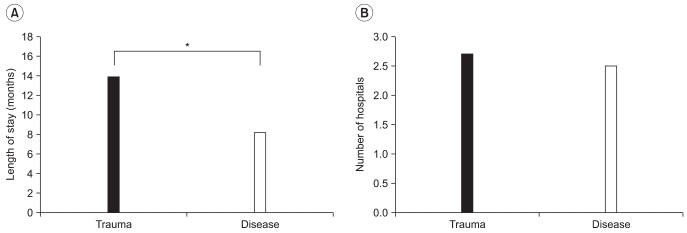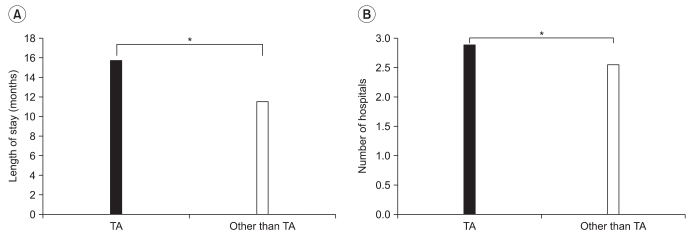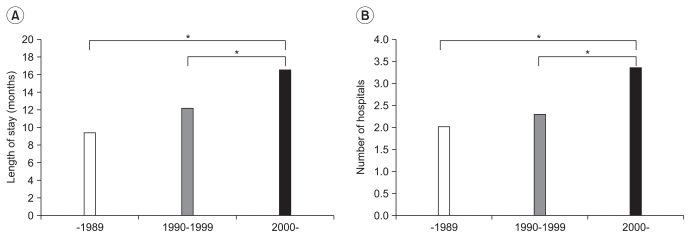Ann Rehabil Med.
2011 Dec;35(6):798-806. 10.5535/arm.2011.35.6.798.
Length of Hospital Stay in Patients with Spinal Cord Injury
- Affiliations
-
- 1Department of Rehabilitation Medicine, Seoul National University College of Medicine, Seongnam 463-707, Korea. hyungik1@snu.ac.kr
- KMID: 2266805
- DOI: http://doi.org/10.5535/arm.2011.35.6.798
Abstract
OBJECTIVE
To provide the latest statistics about the length of hospital stay (LOS) and the number of hospitals where the patient was admitted (NHA) for patients with spinal cord injury (SCI) and to investigate the correlated demographic characteristics. METHOD: In total, 277 patients with SCI who were members of the Korea Spinal Cord Injury Association were included in the analysis. The survey was conducted by self-completed questionnaires to collect data on LOS, NHA, and demographic variables.
RESULTS
Mean LOS was 13.5+/-9.7 months and the mean NHA was 2.7+/-1.4. Patients who suffered from SCI by traffic accidents showed a longer LOS and larger NHA than those with other causes. The mean LOS for patients with traumatic SCI was longer than that whose cause of injury was disease. Patients discharged in the 2000s had a longer LOS and a larger NHA than those discharged earlier. Other factors such as gender, age at the time of injury, neurological category, and ambulation capability did not result in a significant difference in either LOS or NHA.
CONCLUSION
The mean LOS of domestic patients with SCI was longer than the values reported in foreign studies. Interestingly, neither neurological category nor functional status were related to LOS. These findings suggest that other factors such as socio-psychological factors, other than the medical state of the patient, have an effect on the LOS of patients with SCI in Korea.
MeSH Terms
Figure
Reference
-
1. Eastwood EA, Hagglund KJ, Ragnarsson KT, Gordon WA, Marino RJ. Medical rehabilitation length of stay and outcomes for persons with traumatic spinal cord injury: 1990-1997. Arch Phys Med Rehabil. 1999; 80:1457–1463. PMID: 10569441.2. Lee KS, Bae HJ, Kim HS. Utilization of health care resources and costs of stroke patients: patients' perspective. J Korean Neurol Assoc. 2004; 22:583–589.3. Lee BS, Shin HI, Jang SJ, Kim BS. The hospital days and factors influencing on hospital days in patients with spinal cord injury. Proceedings of the 30th Annual Conference of The Korean Academy of Rehabilitation Medicine. 2002. 2002 Oct 17-18; Seoul, Korea. Medrang.4. Kim WS, Kang EK, Shin HI, Bang MS, Shin JC, Park JW. Desire for rehabilitation services of patients with spinal cord injury admitted in post-acute rehabilitation facilities. J Korean Acad Rehab Med. 2008; 32:169–174.5. National Spinal Cord Injury Statistical Center. 2010 Annual statistical report for the spinal cord injury model systems. 2010. Alabama: National Spinal Cord Injury Statistical Center;p. 17–18.6. Norton L. Spinal cord injury Australia 2007-08. 2010. Canberra: Australian Institute of Health and Welfare;p. 15–16.7. de Groot S, Dallmeijer AJ, Post MW, van Asbeck FW, Nene AV, Angenot EL, van der Woude LH. Demographics of the Dutch multicenter prospective cohort study 'Restoration of mobility in spinal cord injury rehabilitation'. Spinal Cord. 2006; 44:668–675. PMID: 16462822.
Article8. Pagliacci MC, Celani MG, Zampolini M, Spizzichino L, Franceschini M, Baratta S, Finali G, Gatta G, Perdon L. An Italian survey of traumatic spinal cord injury. The Gruppo Italiano Studio Epidemiologico Mielolesioni study. Arch Phys Med Rehabil. 2003; 84:1266–1275. PMID: 13680560.9. Hasegawa Y, Ohashi M, Ando N, Hayashi T, Ishidoh T, Kumagai K, Shimazu A. Spinal cord injury hospitalisation in a rehabilitation hospital in Japan. Paraplegia. 1994; 32:47–51. PMID: 8015836.
Article10. Chang H, Yoon SS, Kwon YD. Determinants of inpatient charges of acute stroke patients in two academic hospitals: comparison of intracerebral hemorrhage and cerebral infarction. J Korean Neurol Assoc. 2009; 27:215–222.11. Cho SC, Choi KH, Lee DJ, Ha SB. Interval between initial hospital arrival and start of rehabilitation therapy in sroke patients of tertiary medical center. J Korean Acad Rehabil Med. 1998; 22:9–14.12. Kim WH, Lee KB, Kim SK, Jang SN, Kim BS, Lim HJ, Kim SO. Utilization status of rehabilitation hospital or clinic in patients with stroke. Korean J Stroke. 2005; 7:144–150.13. Rhie KS, Rah UW, Lee IY, Yim SY, Kim KM, Moon DJ, Lee JB. The discharge destination of rehabilitation inpatients in a tertiary hospital. J Korean Acad Rehabil Med. 2005; 29:135–140.14. Tooth L, McKenna K, Geraghty T. Rehabilitation outcomes in traumatic spinal cord injury in Australia: functional status, length of stay and discharge setting. Spinal Cord. 2003; 41:220–230. PMID: 12669086.
Article15. McKinley WO, Seel RT, Gadi RK, Tewksbury MA. Nontraumatic vs. traumatic spinal cord injury: a rehabilitation outcome comparison. Am J Phys Med Rehabil. 2001; 80:693–699. PMID: 11523972.16. Ronen J, Itzkovich M, Bluvshtein V, Thaleisnik M, Goldin D, Gelernter I, David R, Gepstein R, Catz A. Length of stay in hospital following spinal cord lesions in Israel. Spinal Cord. 2004; 42:353–358. PMID: 14968104.
Article17. Celani MG, Spizzichino L, Ricci S, Zampolini M, Franceschini M. Spinal cord injury in Italy: a multicenter retrospective study. Arch Phys Med Rehabil. 2001; 82:589–596. PMID: 11346833.
Article18. Sohn MK, Cho KH, Kim BO, Han SM. Discharge destinations after acute rehabilitation care. J Korean Acad Rehabil Med. 2003; 27:269–274.19. Bryce TN, Ragnarsson KT, Stein AB. Braddom RL, editor. Spinal cord injury. Physical medicine and rehabilitation. 2007. 3rd ed. Philadelphia: Saunders;p. 1287–1288.
Article20. Bae CH, Seo DM. A phenomenological study on life of persons with spinal cord injury - difficulties in social rehabilitation. J Rehabil Res. 2008; 12:117–141.21. Shin EK, Choi JA. Study on factors affecting on the spinal cord injuries' social integration using the structural equation model: analyzing mediating effect of depression, disability identity. J Rehabil Res. 2007; 11:1–29.
- Full Text Links
- Actions
-
Cited
- CITED
-
- Close
- Share
- Similar articles
-
- The Effectiveness of Early Tracheostomy (within at least 10 Days) in Cervical Spinal Cord Injury Patients
- Delayed Spinal Cord Injury Following Low Voltage Electrical Accident
- Spinal Cord Injury Followign Electrical Accidents : Case Reports
- Impact of Early Tracheostomy on Hospital-Acquired Pneumonia and Infection of Anterior Cervical Fusion Site in Patients with Acute Cervical Cord Injury
- Paraplegia Following Spinal Cord Contusion from an Indirect Gunshot Injury




